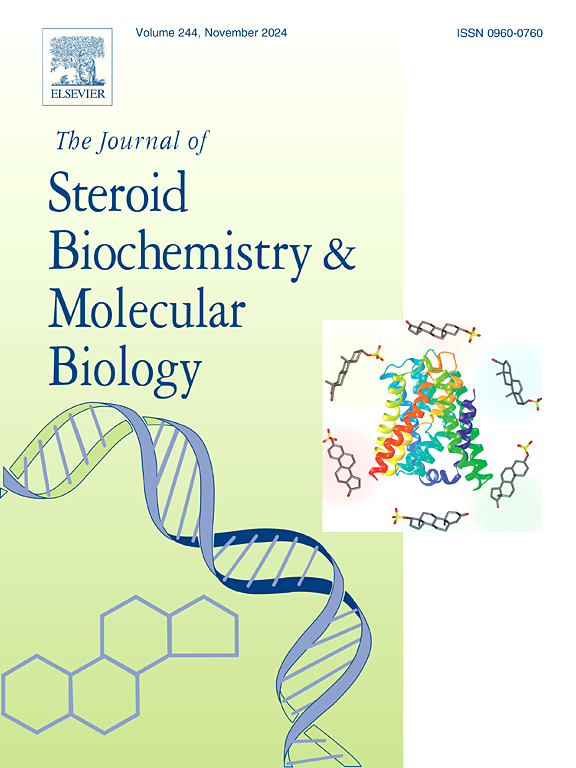Prevalence and determinants of profound vitamin D deficiency (25-hydroxyvitamin D <10 nmol/L) in the UK Biobank and potential implications for disease association studies
IF 2.7
2区 生物学
Q3 BIOCHEMISTRY & MOLECULAR BIOLOGY
Journal of Steroid Biochemistry and Molecular Biology
Pub Date : 2025-03-21
DOI:10.1016/j.jsbmb.2025.106737
引用次数: 0
Abstract
Background
25-hydroxyvitamin D (25OHD) is the principal biomarker of vitamin D status. Values below the assay detection limit (<10 nmol/L) are often reported as missing. Thus the most severely deficient participants are excluded from research which can lead to inaccurate findings such as underestimated prevalence of deficiency, overlooked risk factors, and biased evaluation of disease associations.
Methods
In total 369,626 individuals from the UK Biobank cohort were included in this study. Data on 25OHD concentration and relevant demographic and lifestyle factors such as age, supplement intake, diet, and time spent outdoors were used in the analyses. Ambient UVB radiation was approximated for each participant. 25OHD was evaluated as a categorical outcome and we reintroduced participants with 25OHD values < 10 nmol/L (conventionally reported as missing values) back to the dataset. Adjusted regression models were used to investigate the determinants of profound (25OHD <10 nmol/L) and severe (10–25 nmol/L) vitamin D deficiency and to assess disease associations (with 25–50 nmol/L as the reference category).
Results
1,784 (0.48 %) individuals were profoundly deficient and a further 47,226 (12.78 %) individuals were severely vitamin D deficient. The proportions of profoundly and severely deficient were highest among Asians, 9 % and 47 %, respectively. Ambient UVB radiation was the second strongest predictor: comparing the lowest vs. highest quartile, the risk of profound deficiency was 17-fold increased and that of severe deficiency 7.5-fold increased. Use of vitamin D supplements substantially reduced risk of profound (4.4-fold) and severe (2.5-fold) deficiency, as did fish intake (5- and 1.9-fold, respectively). Profound deficiency was more strongly associated with chronic illness, diabetes, and emphysema compared to severe deficiency.
Conclusion
The prevalence of profound and severe vitamin D deficiency among Asian and Black ethnicities in the UK is high and requires targeted action. Solar radiation is potent in protecting against profound and severe vitamin D deficiency. Studies evaluating the relationship between vitamin D status and other health outcomes may be biased if profoundly deficient participants are excluded.
英国生物银行中深度维生素D缺乏症(25-羟基维生素D <10 nmol/L)的患病率和决定因素及其对疾病关联研究的潜在影响
背景:25-羟基维生素D (25OHD)是维生素D状态的主要生物标志物。低于检测限的值(方法:来自UK Biobank队列的369,626人被纳入本研究。分析中使用了25OHD浓度数据以及相关的人口统计学和生活方式因素,如年龄、补充剂摄入量、饮食和户外活动时间。对每个参与者的环境UVB辐射进行了近似计算。25OHD被评估为分类结果,我们重新引入了具有25OHD值的参与者。结果:1731人(0.48%)严重缺乏维生素D,另外45178人(12.66%)严重缺乏维生素D。极度缺乏和严重缺乏的比例在亚洲人中最高,分别为9%和47%。环境紫外线辐射是第二个最强的预测因素:比较最低和最高四分位数,深度缺乏的风险增加了17倍,严重缺乏的风险增加了7.49倍。维生素D补充剂的使用大大降低了深度(4.4倍)和严重(2.5倍)缺乏的风险,摄入鱼类(分别为5倍和1.87倍)也是如此。与慢性疾病、糖尿病和肺气肿的严重缺乏相比,深度缺乏与更高的优势比相关。结论:在英国非白人种族中,深度和严重维生素D缺乏症的患病率非常高,需要采取有针对性的行动。太阳辐射对预防严重的维生素D缺乏症是有效的。评估维生素D水平与其他健康结果之间关系的研究可能会因排除严重缺乏维生素D的参与者而存在偏差。
本文章由计算机程序翻译,如有差异,请以英文原文为准。
求助全文
约1分钟内获得全文
求助全文
来源期刊
CiteScore
8.60
自引率
2.40%
发文量
113
审稿时长
46 days
期刊介绍:
The Journal of Steroid Biochemistry and Molecular Biology is devoted to new experimental and theoretical developments in areas related to steroids including vitamin D, lipids and their metabolomics. The Journal publishes a variety of contributions, including original articles, general and focused reviews, and rapid communications (brief articles of particular interest and clear novelty). Selected cutting-edge topics will be addressed in Special Issues managed by Guest Editors. Special Issues will contain both commissioned reviews and original research papers to provide comprehensive coverage of specific topics, and all submissions will undergo rigorous peer-review prior to publication.

 求助内容:
求助内容: 应助结果提醒方式:
应助结果提醒方式:


